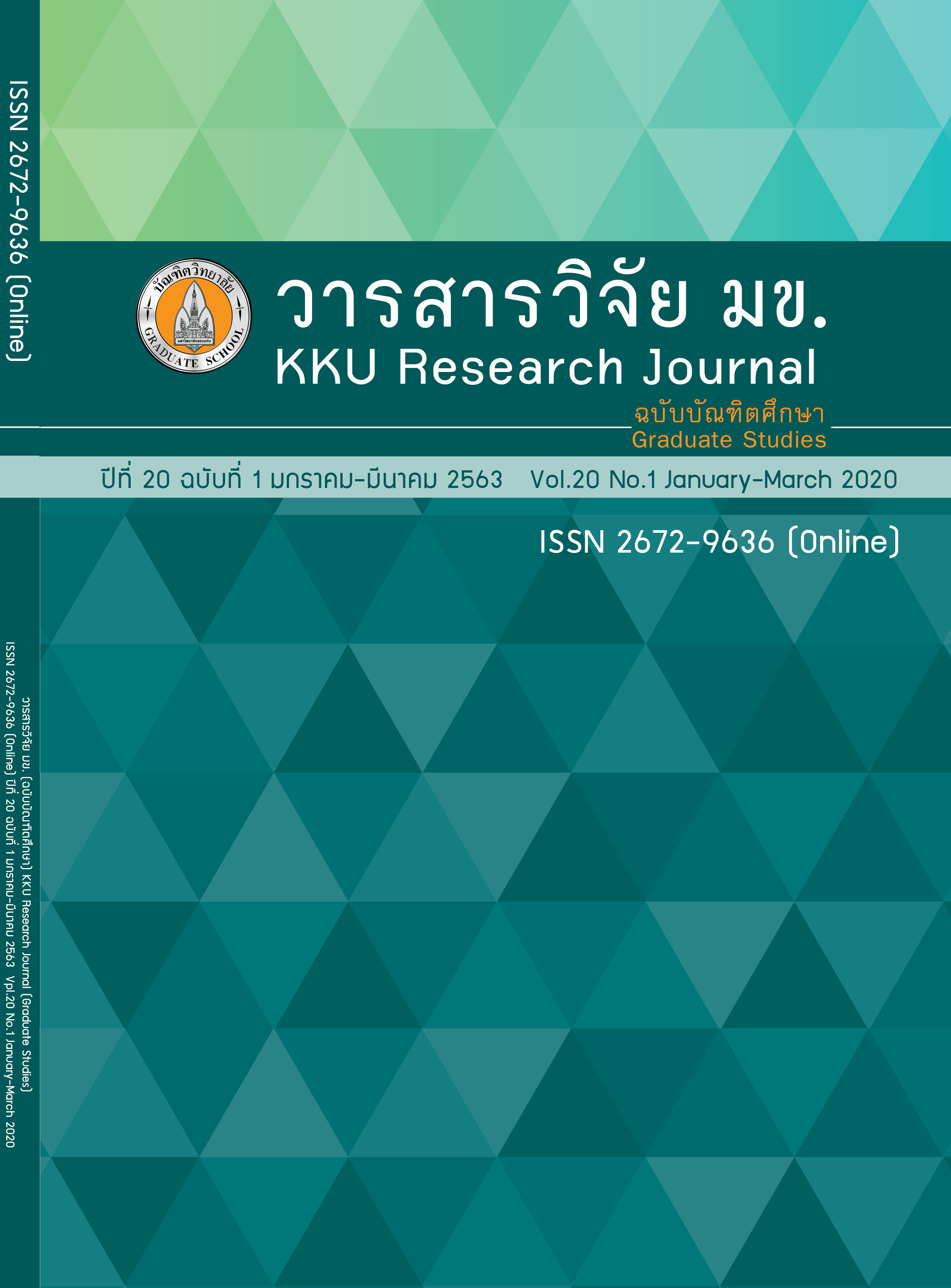Behavioral Characteristics and Factors Associated to Red Light Running of Passenger Car Drivers in Khon Kaen City
Keywords:
Risk taking behavior, Traffic following behavior, Opportunistic behaviorAbstract
Red-Light Running (RLR) was considered as an unsafe action and as the risky behaviors that lead to fatal injury crashes. This study aims to reveal behavioral characteristics and the factors associated to RLR. The video cameras were used to monitor and record the behavior of passenger car drivers on the 3 selected signalized intersections in Khon Kaen city. Total of 6,772 drivers were observed. The logistic regression analysis techniques were used to analyze the behavioral data. The results reveal that the majority of RLR has traffic following behavior (53%), followed by risk taking behavior (25%), and opportunistic behavior (22%). The majority of RLR occurred on the 5 s of before-red time and 5 s of after-red time. This drivers group were higher chance to RLR on the right-turn maneuver, off-peak time, and on the direction with a crossing distance less than 42 meter. These factors have a different effect on each characteristic of RLR behaviors. Measure for control and deter each characteristic of RLR behaviors was presented in this study.
References
WHO. Global Status Report on Road Safety 2013. World Health Organization: 2013.
WHO. Global Status Report on Road Safety 2015. World Health Organization: 2015.
WHO. Global Status Report on Road Safety 2018. World Health Organization: 2018.
Thailand Accident Research Center [Internet]. 2019 [cited 2019 Sep 5]. Available from: https://www.facebook.com/tarc.official/photos/a.280086752093525/2003335409768642/?type=3&theater.
National Statistical Office [Internet]. 2019 [cited 2019 Jan 21]. Available from:
http://service.nso.go.th/nso/web/statseries/statseries21.html
Jensupakarn A, Kanitpong K. Influences of motorcycle rider and driver characteristics and road environment on red light running behavior at signalized intersections. Accid Anal Prev. 2018; 113: 317–324.
Porter BE, England KJ. Predicting Red-Light Running Behavior: A Traffic Safety Study in Three Urban Settings. J Safety Res. 2000; 31(1): 1–8.
Martinez KLH, Porter BE. Characterizing red light runners following implementation of a photo enforcement program. Accid Anal Prev. 2006; 38(5): 862–870.
Retting RA, Ferguson SA, Hakkert AS. Effects of red light cameras on violations and crashes: A review of the international literature. Traffic Inj Prev. 2003; 4(1): 17–23.
Satiennam W, Satiennam T, Triyabutra T, Rujopakarn W. Red light running by young motorcyclists: Factors and beliefs influencing intentions and behavior. Transp Res Part F Traffic Psychol Behav. 2018; 55: 234–245.
Wu C, Yao L, Zhang K. The red-light running behavior of electric bike riders and cyclists at urban intersections in China: An observational study. Accid Anal Prev. 2012; 49: 186–192.
Pai CW, Jou RC. Cyclists’ red-light running behaviours: An examination of risk-taking, opportunistic, and law-obeying behaviours. Accid Anal Prev. 2014; 62: 191–198.
Johnson M, Newstead S, Charlton J, Oxley J. Riding through red lights: The rate, characteristics and risk factors of non-compliant urban commuter cyclists. Accid Anal Prev. 2011; 43(1): 323–328.
Retting RA, Ulmer RG, Williams AF. Prevalence and characteristics of red light running crashes in the United States. Accid Anal Prev. 1999; 31(6): 687–694.
Harb R, Radwan E, Yan X. Larger size vehicles (LSVs) contribution to red light running, based on a driving simulator experiment. Transp Res Part F Traffic Psychol Behav. 2007; 10: 229–241.
Retting RA, Williams AF. Characteristics of red light violators: Results of a field investigation. J Safety Res. 1996; 27(1): 9–15.
Elmitiny N, Yan X, Radwan E, Russo C, Nashar D. Classification analysis of driver’s stop/go decision and red-light running violation. Accid Anal Prev. 2010; 42(1): 101–111.
Chang MS, Messer CJ, Santiago AJ. Timing Traffic Signal Change Intervals Based on Driver Behavior. Transp Res Rec. 1985: 20–30.
Fraboni F, Marín Puchades V, De Angelis M, Pietrantoni L, Prati G. Red-light running behavior of cyclists in Italy: An observational study. Accid Anal Prev. 2018; 120: 219–232.
Khon Kaen Regional Hospital. 21 Years Anniversary Trauma Registry 1997-2017. Thailand; 2018.
Yan F, Li B, Zhang W, Hu G. Red-light running rates at five intersections by road user in Changsha, China: An observational study. Accid Anal Prev. 2016; 95: 381–386.
Lum KM, Wong YD. Impacts of red light camera on violation characteristics. J Transp Eng. 2003; 129(6): 648–656.
Sze NN, Wong SC, Pei X, Choi PW, Lo YK. Is a combined enforcement and penalty strategy effective in combating red light violations? An aggregate model of violation behavior in Hong Kong. Accid Anal Prev. 2011; 43(1): 265–271.
Federal Highway Administration (FHWA). Marking Intersections Safer: A Toolbox of Engineering Countermeasures to Reduce Red-Light Running. Vol. 21 An Informational Report; 2003.



